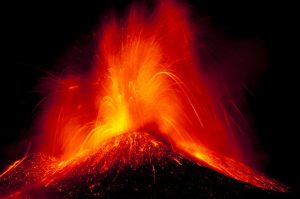
Volcanoes are geology at its most exciting. They seem so fiery, dangerous and thrillingly explosive. That may be true, but most old and mature volcanoes are surprisingly stuck in their ways and even if when they will blow is difficult to forecast, where they will blow from is often more predictable.
The majority of volcanoes look as they do in a child’s drawing; like a steep mountain with its head cut off. They have a summit crater and, if they erupt, it is from this rocky orifice that lava and ash spews. But this is not the case with Mount Etna on the Island of Sicily, Italy, a study published in the open-access journal Frontiers in Earth Science found.
Etna has been collecting new summits as though they are Pokémon. It is as if the mountain has had an outbreak of acne, with multiple cones forming in a geologically short space of time. According to Professor Valerio Acocella, of Roma Tre University and his colleagues from Ingv Catania, this makes Etna “perfect for study.”
Valerio and his fellow researchers have been using data collected over the past ten years from thermal imaging satellites, ground measurements and onsite monitoring of the volcano to document its unruly behavior and try and work out why it has more vents than most volcanoes.
Valerio claims that “the fact that Etna is continuously active allows us to capture many evolutionary processes, within a decade or less, which, at any other volcano would (only) be seen over much larger spans of decades or centuries.” As a consequence, “Etna is probably one of the best monitored and studied volcanoes in the world.”
The team observed how over the past few decades eruptions have moved from a central crater to a new one developed to its south, before that too was soon abandoned and another cone, to the southeast, quickly formed and rose to dominance. The researchers attribute this wandering eruptive activity to an instability on the volcano’s eastern flank.
It is as if the mountain is suffering subsidence, with the weight of the summit being undercut by the movement of the volcano’s lower portion to the east. This is causing new stresses and pressures to the structure as a whole. But this is more than just an academic study seeking to understand the history of a world famous and fascinating volcano.
Being able to calculate where and when Etna might erupt in the future is of pivotal importance to the people who live near it. Valerio and his colleagues warn that the new zones of weakness recently formed on the volcano summit may result from these processes and may an increase the chance of volcanic eruptions and landslide hazards.
Reference:
Valerio Acocella, Marco Neri, Boris Behncke, Alessandro Bonforte, Ciro Del Negro, Gaetana Ganci. Why Does a Mature Volcano Need New Vents? The Case of the New Southeast Crater at Etna. Frontiers in Earth Science, 2016; 4 DOI: 10.3389/feart.2016.00067
Note: The above post is reprinted from materials provided by Frontiers.









